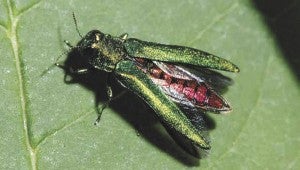Mower County officials call for vigilance to prevent ash borers
Published 10:26 am Thursday, September 11, 2014
By Jason Schoonover, Austin Daily Herald
AUSTIN — After emerald ash borers were found in a neighboring county, Mower County and state leaders say it’s important for residents to be vigilant by watching their trees for signs of stress and by never transporting firewood.
The Minnesota Department of Agriculture confirmed an emerald ash borer infestation in Olmsted County near the interchange of Interstate 90 and U.S. Highway 63 in late August. The infested trees were about 45 miles from the nearest emerald ash borer find in Winona County.
“Having it one step closer, it’s just that much more of a concern,” said Jeanine Vorland, a regional wildlife manager with the Minnesota Department of Natural Resources.
But people aren’t ready to concede that it’s only a matter of time before the ash tree-killing insect makes it to Mower.
Vorland is hopeful it won’t spread further, as ash borers have a limited flight distance and are most commonly transported to new areas by people moving firewood.
Still, city leaders and others are watching closely.
“It should concern everybody,” Parks and Rec Director Kim Underwood said.
In 2010, a city inventory found ash accounted for about 17 percent of Austin’s trees, according to Underwood.
“We’re concerned, but we’ve been talking about it for several years,” she said.
While the Jay C. Hormel Nature Center doesn’t have a plan in place if an infestation reached its woods, Executive Director Larry Dolphin said it’s something that concerns them, as ash trees are one of the center’s more predominant varieties.
“It is a fairly common tree that we have in the woods,” he said. “There would certainly be a significant impact if we had to go and take out ash trees.”
Like all state parks, Vorland noted Lake Louise State Park on the eastern end of Mower County near LeRoy is a concern.
“It would be pretty devastating if it got in there,” Vorland said, adding that the park has a “beautiful forest.”
Since Lake Louise isn’t staffed as heavily as other state parks, Vorland said it’s important for people to not transport firewood into the park.
Vorland described ash trees as an important resource for the state, and she urged residents to be diligent about watching trees for signs of stress: dead branches and, especially, D-shaped holes in the bark — a telltale sign of emerald ash borers.
Cindy Lippert, garden center manager at Dolan’s Landscape Center, echoed that sentiment.
“I think we just have to be vigilant,” she said. “Keep an eye on your trees and watch out for them.”
Though emerald ash borers aren’t prone to fly long distances on their own, it’s often hard to spot an emerald ash borer infestation, as the insects get under the bark and spread through the tree before it’s noticed, Vorland noted. She urged residents to report possible signs of emerald ash borers to the department of agriculture. If emerald ash borers were spotted in Mower, the county would be quarantined like Olmsted, Hennepin, Houston, Ramsey and Winona counties are.
Though many are worried, Lippert said there’s no reason for people to cut ashes down, noting Dutch elm disease didn’t kill all the elms.
If an ash is found to have the insect, it’s not necessarily time to panic. Dolan’s sells Imidacloprid, a systemic insect drench that can eradicate a small infestation. The chemical is mixed in water and then poured to soak into the roots.
In light of emerald ash borer, Dolan’s hasn’t sold ash trees for several years.
Underwood said applications to fight the ash borer, like the one at Dolan’s, likely wouldn’t be cost effective for the city.
Most see emerald ash borer as the latest lesson for diversification in tree plantings — both for health and to add a more pleasing variety. Dolphin said it’s important at the nature center, and Underwood, Vorland and Lippert agreed.
“It’s so much more interesting to have a variety of trees,” Lippert said.






